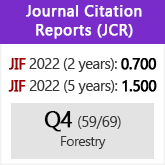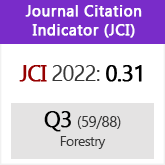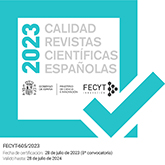Economic and environmental assessment of a multifunctional poplar plantation for roundwood and wood chip production in Spain
Abstract
Aim of study: To analyze the environmental and economic performance of a multifunctional poplar plantation (MPP), which was managed to produce timber for sawn wood and chips for bioenergy.
Area of study: The plantation was located in Southern Spain producing roundwood and woodchips (from tops and branches).
Material and methods: The life cycle assessment (LCA) methodology was chosen to perform the environmental impact assessment from a cradle-to-gate perspective. Capital goods, including machinery-manufacturing processes, were included. One oven dry tonne (odt) of forest biomass was chosen as functional unit. The economic analysis was performed using present costs and common indicators: net present value (NPV) and internal rate of return (IRR).
Main results: The harvest operations are the most environmental impacting subsystem and cultivation the costliest. Chipping was the process contributing the most to the environmental burden. The use of fertilizers, within the cultivation subsystem, had a notable impact on certain midpoint categories. In terms of climate change potential, 1 odt of delivered wood chips generated 64.1 kg CO2-eq. When considering the whole system (including the roundwood fraction), this value was 45.2 kg CO2-eq odt-1. MPP was hardly profitable with land rental and irrigation being the most expensive items. NPV, including harvesting and transport subsystems, was 1,582 € ha-1, while IRR reached 6.3%.
Research highlights: Our results allow to identify the costliest operations and those with the greatest impact to improve the system. Finally, these figures can be compared with other crop alternatives such us poplar short rotation coppice (SRC).
Downloads
References
Ackerman P, Lyons J, Eliasson L, Heunis G, Grulois S, De Jong A, 2012. Equipment costing model. A business model Cost Action FP0902. WG3. Forest Energy Action. Stellenbosch University, South Africa.
Arboleda N, 2014. El cultivo de chopo y otros cultivos agrícolas en la Vega de Granada. Final Degree Thesis, unpublised. Universidad Politécnica de Madrid.
Banco de Datos de la Naturaleza, 2006. Mapa forestal español 1:50.000. https://www.miteco.gob.es/es/biodiversidad/servicios/banco-datos-naturaleza/informacion-disponible/mfe50.aspx [5 Aug 2020].
Barrio-Anta M, Sixto-Blanco H, Viñas ICD, Castedo-Dorado F, 2008. Dynamic growth model for I-214 poplar plantations in the northern and central plateaux in Spain. For Ecol Manage 255 (3-4), 1167-1178. https://doi.org/10.1016/j.foreco.2007.10.022
Butnar I, Rodrigo J, Gasol CM, Castells F, 2010. Life-cycle assessment of electricity from biomass: Case studies of two biocrops in Spain. Biomass Bioenerg 34 (12): 1780-1788. https://doi.org/10.1016/j.biombioe.2010.07.013
Cañellas I, Huelin P, Hernández MJ, Ciria P, Calvo R, Gea-Izquierdo G, Sixto H, 2012. The effect of density on short rotation Populus sp. plantations in the Mediterranean area. Biomass Bioenerg 46: 645-652. https://doi.org/10.1016/j.biombioe.2012.06.032
Cherubini F, Bird ND, Cowie A, Jungmeier G, Schlamadinger B, Woess-Gallasch S, 2009. Energy- and greenhouse gas-based LCA of biofuel and bioenergy systems: Key issues, ranges and recommendations. Resour Conserv Recycl 53 (8): 434-447. https://doi.org/10.1016/j.resconrec.2009.03.013
Cherubini F, Stromman AH, 2011. Life cycle assessment of bioenergy systems: State of the art and future challenges. Bioresour Technol 102 (2): 437-451. https://doi.org/10.1016/j.biortech.2010.08.010
Chiarabaglio PM, Deidda A, Bergante S, Castro G, Facciotto G, Giorcelli A, et al., 2020. Life cycle assessment (LCA): new poplar clones allow an environmentally sustainable cultivation. Ann Silvic Res 45 (1): 76-82.
De La Fuente T, Athanassiadis D, González-García S, Nordfjell T, 2017. Cradle-to-gate life cycle assessment of forest supply chains: Comparison of Canadian and Swedish case studies. J Clean Prod 143: 866-881. https://doi.org/10.1016/j.jclepro.2016.12.034
De La Fuente T, Bergström D, González-García S, Larsson SH, 2018. Life cycle assessment of decentralized mobile production systems for pelletizing logging residues under Nordic conditions. J Clean Prod 201: 830-841. https://doi.org/10.1016/j.jclepro.2018.08.030
Ericsson K, Rosenqvist H, Nilsson LJ, 2009. Energy crop production costs in the EU. Biomass Bioenerg 33 (11): 1577-1586. https://doi.org/10.1016/j.biombioe.2009.08.002
FAFCYLE, 2021. FAFCYLE vende 16 lotes de madera de chopo en Zamora por algo más de 2 millones € con un 43% de incremento de venta. Forestry owner association of the Castilla y León Region, Spain. https://www.fafcyle.es/subastas-de-chopo/ [8 Aug 2020].
Fernández L, Rubio R, Gallego R, 2018. Metodología para la evaluación de la sostenibilidad económico-financiera de las choperas en Castilla y León. Actas II Simp Chopo, Valladolid. https://www.simposiodelchopo.es/sites/default/files/actas/actas.pdf.
García HI, 2018. Consumo de la madera de chopo: presente y futuro. Actas II Simp Chopo, Junta de Castilla y León, Valladolid. 392 pp.
Gasol C, Martinez S, Rigola M, Rieradevall J, Anton A, Carrasco J, et al., 2009. Feasibility assessment of poplar bioenergy systems in the Southern Europe. Renew Sust Energ Rev 13 (4): 801-812. https://doi.org/10.1016/j.rser.2008.01.010
Gobierno Vasco, 2017. Simulador del coste de transporte de mercancías por carretera. https://www.euskadi.eus/gobierno-vasco/transportes/simuladores/ [29 Jul 2019].
Goedkoop MJ, Heijungs R, Huijbregts M, De Schryver A, Struijs J, Van Zelm R, 2009. ReCiPe 2008, a life cycle impact assessment method which comprises harmonised category indicators at the midpoint and the endpoint level. Report I: Characterisation. http://www.lcia-recipe.net.
Gonzalez-Garcia S, Dias AC, Clermidy S, Benoist A, Maurel VB, Gasol CM, et al., 2014. Comparative environmental and energy profiles of potential bioenergy production chains in Southern Europe. J Clean Prod 76: 42-54. https://doi.org/10.1016/j.jclepro.2014.04.022
Hauk S, Knoke T, Wittkopf S, 2014. Economic evaluation of short rotation coppice systems for energy from biomass-A review. Renew Sust Energ Rev 29: 435-448. https://doi.org/10.1016/j.rser.2013.08.103
Hildreth JC, Chen D, 2018. Assessment of heavy equipment operating cost estimates from annual data. Int J Constr Eng Manage 7(4): 125-132.
Hischier R, Weidema B, 2010. Implementation of life cycle impact assessment methods. Swiss Centre for Life Cycle Inventories, Ecoinvent Centre, Ecoinvent report No 3.
IPCC, 2006. 4: Agriculture, Forestry and Other Land Uses (AFOLU). IPCC/Guidelines for National Greenhouse Gas Inventories. IPCC/IGES, Hayama, Japan.
ISO, 2006. ISO 14040 Environmental management - life cycle assessment - principles and framework. International Organization for Standardization, Geneva.
Johnson L, Lippke B, Oneil E, 2012. Modeling biomass collection and wood processing life cycle analysis. Forest Prod J 62(4): 258-272. https://doi.org/10.13073/FPJ-D-12-00019.1
López VE, Casquet Morate E, Díaz Balteiro L, 2005. El turno financiero óptimo al introducir la fiscalidad en el análisis. Aplicación a las choperas de Castilla y León. Invest Agrar: Sist Recur For 14 (1): 122-136. https://doi.org/10.5424/srf/2005141-00878
Lovarelli D, Fusi A, Pretolani R, Bacenetti J, 2018. Delving the environmental impact of roundwood production from poplar plantations. Sci Total Environ 645: 646-654. https://doi.org/10.1016/j.scitotenv.2018.06.386
MAPA, 2020a. Anuario de estadística forestal 2018. Ministerio de Agricultura, Pesca y Alimentación, Gobierno de España. https://www.mapa.gob.es/es/desarrollo-rural/estadisticas/aef_2018_documentocompleto_tcm30-543070.pdf [27 Mar 2020].
MAPA, 2020b. Encuesta de cánones de arrendamiento rústico año 2019. Ministerio de Agricultura, Pesca y Alimentación, Gobierno de España. https://www.mapa.gob.es/es/estadistica/temas/estadisticas-agrarias/canonesdearrendamiento2019_r1_tcm30-553576.pdf [27 Mar 2020].
Murphy F, Devlin G, McDonnell K, 2014. Forest biomass supply chains in Ireland: A life cycle assessment of GHG emissions and primary energy balances. Appl Energ 116: 1-8. https://doi.org/10.1016/j.apenergy.2013.11.041
Perez-Cruzado C, Sanchez-Ron D, Rodriguez-Soalleiro R, Jose Hernandez M, Sanchez-Martin M, Canellas I, Sixto H, 2014. Biomass production assessment from Populus spp. short-rotation irrigated crops in Spain. GCB Bioenerg 6 (4): 312-326. https://doi.org/10.1111/gcbb.12061
Pichio R, Verani S, Sperandio G, Spina R, Marchi E, 2012. Stump grinding on a poplar plantation: working time, productivity, and economic and energetic inputs. Ecol Eng 40: 117-120. https://doi.org/10.1016/j.ecoleng.2011.11.012
Powers SE, 2005. Quantifying cradle-to-farm gate life-cycle impacts associated with fertilizer used for corn, soybean, and stover production. Nat Renew Energ Lab, Technical Report NREL/TP-510-37500. https://doi.org/10.2172/1216408
San Miguel G, Corona B, Ruiz D, Landholm D, Laina R, Tolosana E, et al., 2015. Environmental, energy and economic analysis of a biomass supply chain based on a poplar short rotation coppice in Spain. J Clean Prod 94(1): 93-101. https://doi.org/10.1016/j.jclepro.2015.01.070
Savoie P, Current D, Robert F, Hebert PL, 2012. Harvest of natural shrubs with a biobaler in various environments in Quebec, Ontario and Minnesota. Appl Eng Agr 28 (6): 795-801. https://doi.org/10.13031/2013.42473
Schweier S, Schnitzler JP, Becher G, 2016. Selected environmental impacts of the technical production of wood chips from poplar short rotation coppice on marginal land. Biomass Bionerg 85: 235-242. https://doi.org/10.1016/j.biombioe.2015.12.018
Schweier S, Molina-Herrera S, Ghirardo A, Grote R, Días-Pines E, Kreuzwieser J, et al., 2017. Environmental impacts of bioenegy wood production from poplar short-rotation coppice grown at a marginal agricultural site in Germany. GCB Bioenerg 9: 1207-1221. https://doi.org/10.1111/gcbb.12423
Sixto H, Hernández MJ, Ciria P, Carrasco JE, Cañellas I, 2010. Manual de cultivo de Populus spp. para la producción de biomasa con fines energéticos. Monografias INIA, Ser For nº 21, Madrid, ISBN 978-84-7498-530-6.
Spinelli R, Nati C, Magagnotti N, 2009. Using modified foragers to harvest short rotation poplar plantations. Biomass Bioenerg 33 (5): 817-821. https://doi.org/10.1016/j.biombioe.2009.01.001
Testa R, Di Trapani AM, Fodera M, Sgroi F, Tudisca S, 2014. Economic valuation of introduction of poplar as biomass crop in Italy. Renew Sustain Energ Rev 38: 775-780. https://doi.org/10.1016/j.rser.2014.07.054
Tolosana E, Laina R, Martínez-Ferrari R, Ambrosio Y, 2011. Recovering of forest biomass from Spanish hybrid poplar plantations. Biomass Bioenerg 35 (7): 2570-2580. https://doi.org/10.1016/j.biombioe.2011.02.007
Copyright (c) 2022 Forest Systems

This work is licensed under a Creative Commons Attribution 4.0 International License.
© CSIC. Manuscripts published in both the printed and online versions of this Journal are the property of Consejo Superior de Investigaciones Científicas, and quoting this source is a requirement for any partial or full reproduction.
All contents of this electronic edition, except where otherwise noted, are distributed under a “Creative Commons Attribution 4.0 International” (CC BY 4.0) License. You may read here the basic information and the legal text of the license. The indication of the CC BY 4.0 License must be expressly stated in this way when necessary.
Self-archiving in repositories, personal webpages or similar, of any version other than the published by the Editor, is not allowed.















